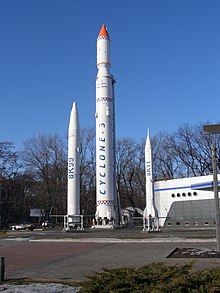

The R-11 Zemlya (Russian: Р-11 Земля, lit. 'Earth'), GRAU index 8A61 was a Soviet tactical ballistic missile. It is also known by its NATO reporting name SS-1b Scud-A. It was the first of several similar Soviet missiles to be given the reporting name Scud. Variant R-11M was accepted into service, with GRAU index 9K51 (9К51).
Origin
The R-11 originated from a 1951 requirement for a ballistic missile with similar performance to the German V-2 rocket, but half its size. With the Wasserfall, an anti-aircraft version of the V-2, as a model the R-11 was developed by engineer Victor Makeev, who was then working in OKB-1, headed by Sergey Korolyov. The two men agreed on the use of RG-1 as the fuel, but disagreed over which oxidizer to use, with Korolev favouring the use of liquid oxygen, while Makeev advocated the use of a storable but toxic oxidizer. Makeev's version, that first flew on 18 April 1953, was fitted with an Isayev engine using RG-1 and nitric acid. On 13 December 1953, a production order was passed with SKB-385 in Zlatoust, a factory dedicated to producing long-range rockets. In June 1955, Makeev was appointed chief designer of the SKB-385 to oversee the programme and, in July, the R-11 was formally accepted into military service. The definitive R-11M, designed to carry a nuclear warhead, was accepted officially into service on 1 April 1958. The launch system received the GRAU index 9K51, the rocket itself 8K11, and the launcher 8U218.
Systems specification
Like the V-2, the R-11 relied on inertial guidance, and its flight was controlled by four graphite vanes in the engine exhaust, that were active only while the motor was burning. The R-11M had a maximum range of 270 km (170 mi), but when carrying a nuclear warhead, this was reduced to 170 km (110 mi), hence an alternative designation R-170. At maximum range, it was found to have an average range error 1.19 km (0.74 mi) and an azimuth error of 660 m (0.41 mi). It was used as a mobile nuclear strike vector, giving the Soviet Army the ability to hit European targets from forward areas. To give the system sufficient mobility on the battlefield, the R-11 was mounted on the chassis of an IS-2 tank, that became its first transporter erector launcher 8U218. Main payload was a nuclear warhead with an estimated yield of 10, 20 or 40 kilotons. There was also HE-Frag warhead 9N33 with 535 kg (1,179 lb) of explosive.

Naval variant
A naval variant, the R-11FM was first tested at Kapustin Yar in February 1955, and was first launched from a converted Project 611 (Zulu class) submarine in September of the same year. While the initial design was done by Korolev's OKB-1, the programme was transferred to Makeyev's SKB-385 in August 1955. It became operational in 1959 as the D-1 launch system, the world's first submarine-launched ballistic missile (SLBM), and was deployed onboard Project 611 and Project 629 (Golf Class) submarines, until its replacement by the R-13 in 1961 (SS-N-4) and the R-21 (SS-N-5) in 1963. During its service, 77 launches were conducted, of which 59 were successful. The success of the R-11FM established Makeev as the main designer of submarine-launched weapons for the Soviet Armed Forces, and the R-11FM served with the first generation SLBM submarine units of the Soviet Navy.
See also
References
- Johnston's Archive – Soviet/Russian Missile Designations
- ^ Wade, Mark. "R-11". Encyclopedia Astronautica. Archived from the original on March 9, 2002. Retrieved 2008-02-17.
- ^ Rochowicz, Robert (2018) (in Polish). Rakiety operacyjne i taktyczne w Siłach Zbrojnych PRL. „Poligon” No. 1/2018(62), pp. 56–63, ISSN 1895-3344
- Zaloga, p. 4
- "Rocket R-11". RSC "Energia". Retrieved 2021-01-01.
- Zaloga, p. 8
- "SS-1 'Scud' (R-11/8K11, R-11FM (SS-N-1B) and R-17/8K14)". Jane's Information Group. 26 April 2001. Archived from the original on 2007-12-15. Retrieved 2008-02-12.
- "R-11FM / SS-1b Scud". Federation of American Scientists. July 13, 2000. Retrieved 2008-02-19.
External links
- Ballistic Missile Reference from the Federation of American Scientists
- Missile Threat: A Project of the George C. Marshall Institute
- R-11 / SS-1B SCUD-A
| Scud missiles and derivatives | ||
|---|---|---|
 | ||
| Russian and former Soviet military designation sequences for radar, missile and rocket systems | |||||||||||||||||||||||
|---|---|---|---|---|---|---|---|---|---|---|---|---|---|---|---|---|---|---|---|---|---|---|---|
| Radar systems |
| ||||||||||||||||||||||
| Missiles |
| ||||||||||||||||||||||
| Unguided rockets |
| ||||||||||||||||||||||
| Engines | |||||||||||||||||||||||
| USAF/DoD reporting names for Soviet and Chinese aircraft and missiles | |||||||||||||||||||
|---|---|---|---|---|---|---|---|---|---|---|---|---|---|---|---|---|---|---|---|
| Type numbers (1947–1955) | |||||||||||||||||||
| Research/prototype aircraft |
| ||||||||||||||||||
| Research/prototype missiles |
| ||||||||||||||||||
| Listed in contemporary sources • Bergander list (details) • Unknown/no details • Possible error • Unconfirmed | |||||||||||||||||||